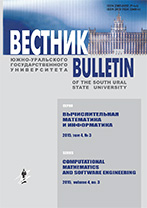|
This article is cited in 2 scientific papers (total in 2 papers)
Studying the Picard's method for solving the inverse Cauchy problem for heat conductivity equations
H. K. Al-Mahdawi
South Ural State University (pr. Lenina 76, Chelyabinsk, 454080 Russia)
Abstract:
In this paper, the inverse Cauchy problem for the heat equation is posed and solved. In this problem, the initial temperature is unknown, and instead of it, the temperature at a specific time is given, $t = T > 0$. They are characterized by the fact that arbitrarily small changes in the source data can lead to large changes in the solution. It is well known that this problem is an ill-posed problem. In order to solve the direct problem, the method of separation of variables is used. We noticed that the method of separating variables is not applicable to solving the inverse Cauchy problem since it leads to large errors, as well as to divergent rows. V.K. Ivanov noted that if the inverse problem is solved by the method of separation of variables, the resulting series is replaced with a partial sum of a series, where the number of terms depends on $\delta$, $N=N(\delta)$. The Picard's method uses the regularizing family of $\{R_N\}$, operators mapping the $L_2[0, 1]$ space into itself. The results of computational experiments are presented and the effectiveness of this method is estimated.
Keywords:
inverse heat conduction problem, Picart’s method, ill-posed problem, Cauchy problem.
Received: 08.01.2019
Citation:
H. K. Al-Mahdawi, “Studying the Picard's method for solving the inverse Cauchy problem for heat conductivity equations”, Vestn. YuUrGU. Ser. Vych. Matem. Inform., 8:4 (2019), 5–14
Linking options:
https://www.mathnet.ru/eng/vyurv220 https://www.mathnet.ru/eng/vyurv/v8/i4/p5
|

| Statistics & downloads: |
| Abstract page: | 191 | | Full-text PDF : | 62 | | References: | 21 |
|




 Contact us:
Contact us: Terms of Use
Terms of Use
 Registration to the website
Registration to the website Logotypes
Logotypes







 Citation in format
Citation in format 
